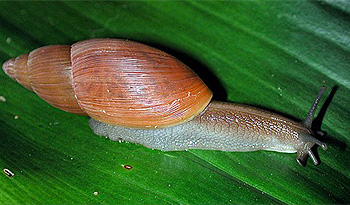
Rosy wolf snail (Euglandina rosea), adult specimen.
Picture: Jim Miller, Jacksonville Shell Club.
 Rosy wolf snail (Euglandina rosea), adult specimen. Picture: Jim Miller, Jacksonville Shell Club. |
|
Film: The Totaly Adorable "Rosy Wolfsnail" (Florida in Your Backyard). Video by Jesse King on YouTube. |
Wolf snails are part of the mainly neotropical land snail family Oleacinidae (see: Systematics), whose area of distribution spreads from South America over Central America as far north as the southeastern United States, except for a few species that settled in the Mediterranean.
In Florida for example the rosy wolf snail (Euglandina rosea) can be encountered. About 10 cm (4 in.) long, the rosy wolf snail is a carnivorous snail, which contrary to many other carnivorous snail species, is a specialized snail hunter.
Taking a closer look at a wolf snail's head, the snail appears to have three pairs of tentacles: Clearly, the larger pair can be distinguished as the eye stalks, the smaller ones as the mainly olfactory and tactile tentacles. The lowest of the three pairs of tentacles actually are the lips which are equipped with chemical sensors used by the snail to taste and smell the ground. In the case of the wolf snail, the strongly extended lips are used to track the prey by following its slime trail. Hence the name wolf snail, the parallels to a wolf stalking its prey following the scent are obvious, the difference being that the snail rather uses the sense of taste than smell. From the slime trail, the wolf snail can also determine what kind of creature it is following, a conspecific or another species of snail.
Following its prey, the wolf snail does not move at a normal snail's pace but double or triple the speed of a regular snail. It follows its prey up trees and even short distances underwater. Wolf snails not only feed on snails in general, but they are also potential cannibals - freshly hatched baby wolf snails even feed on eggs and smaller siblings. Generally, the wolf snail prefers to feed on smaller snails it can swallow whole, including the shell. The advantage is apparent: The prey's shell also provides the predator with a source to build its own shell. The American malacologist Harry G. Lee reported that he found no less than 13 snail shells by dissecting a medium-sized specimen of Euglandina rosea. ("Shells are where you find them").
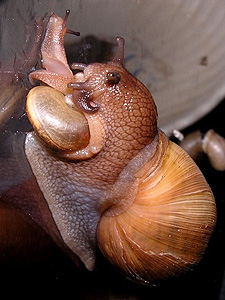 Euglandina feeding on Bradybaena similaris. Picture: Bill Frank, Jacksonville Shell Club. |
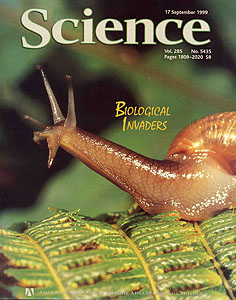 Euglandina rosea on the cover of Science (Vol. 285, Sept. 99). Source: R.H. Cowie. |
|
|
Chin Frank: Euglandina rosea Rosy Wolfsnail vs. Triodopsis hopetonensis Magnolia Threetooth Snail: YouTube Video. | |
|
|
theMolluskMan: Euglandina rosea (Rosy Wolf Snail) on the hunt!: Rosy wolf snail eating several smaller land snails. YouTube Video. Note: Detailed and rather brutal display! |
Wolf snails also feed on slugs. During observations, it could be seen that field slugs (Deroceras) try to evade a wolf snail's attack by vigorously moving its tail. If the wolf snail is unable to grab the slug's tail, the slug might be able to get away. Similar strategies are applied by the jumping slugs of Pacific Canada and the northeastern USA. In the example shown below, the wolf snail attacks the slug's head to avoid that strategy.
|
|
Jacksonville Shell Club (Jaxshells): Euglandina rosea hunting a meadow slug: Euglandina rosea hunts and eats a field slug (Deroceras laeve). Picture series. |
Rosy wolf snails had been introduced by man to different Pacific islands (Hawaii, Marianas, Polynesia) as a biological weapon against the likewise introduced giant African land snails (Achatina fulica). But instead of feeding on the giant snails destroying large areas of agricultural land, the wolf snails preferably hunted smaller endemic (species living only in one particular place) tree snail species (Partula, Achatinella u. a.), which were a lot more suitable to the wolf snail's prey preferences of hunting smaller snails.
Most populations of small endemic tree snails had nothing to catch up to the increased predator pressure by the wolf snails.
Today, many tree snail species have gone extinct, with the exception of some populations living in zoos. Some have to be considered as irretrievably lost. Using the knowledge of American wolf snails' feeding habits, it should have been possible to predict the ecological impact of introducing wolf snails to new ecosystems. Local authorities, however, chose to ignore the advice of concerned malacologists and ecologists. In the meantime, there have been attempts by different European and American zoos to resettle endangered Partula snails bred in zoos to their native environment, e.g. on the island of Tahiti.
Additional Information:
![]() Harry G. Lee: Shells
are where you find them.
Harry G. Lee: Shells
are where you find them.
![]() Jim Miller, Bill Frank: Rosy
wolf snail (Euglandina rosea) - A Pictorial.
Jim Miller, Bill Frank: Rosy
wolf snail (Euglandina rosea) - A Pictorial.
![]() Major Biology:
This Snail
is Destroying Hawaii's Ecosystems. YouTube Video.
Major Biology:
This Snail
is Destroying Hawaii's Ecosystems. YouTube Video.
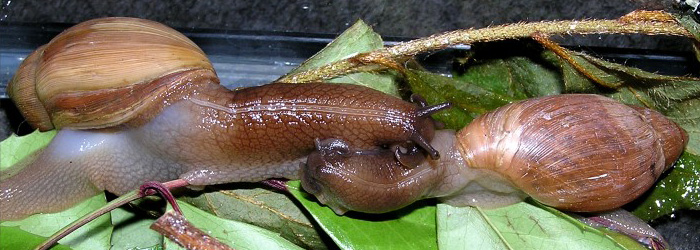
Two wolf snails mating. Picture: Bill Frank,
Jacksonville Shell Club.
Systematics and related species
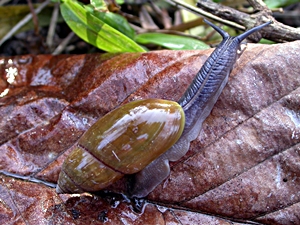 Eine Raubschnecke der Gattung Streptostyla aus Honduras. Bild: John Slapcinsky, Quelle: Flickr. |
|
Subclass:
Pulmonata |
|
| Systematic order according to Fauna Europaea (Bank, R., 2011) |
The rosy wolf snail Euglandina rosea is part of the Testacelloidea superfamily, together with several other carnivorous snail species, most of which live in the Neotropic: Northern South America, Central America and the south-eastern part of the United States. Only some species, mainly of the Poiretia genus, are to be found in the Mediterranean.
Like the superfamily's scientific name Testacelloidea suggests, the Oleacinidae are also related to the predatory shelled slugs of the Testacella genus, which is mainly distributed in Western Europe. Contrary to those semi-slugs, which carry only a rudimentary shell on the end of their back, the Oleacinidae snails have complete shells they are able to withdraw into.
Among the European genera of the Oleacinidae family, there are, for example, the Mediterranean carnivorous species of the Poiretia genus, e.g. the Dalmatian predator snail (Poiretia cornea). Those share a subfamily with the wolf snail genus Euglandina, more species of which occur further south in Central America. Another subfamily are the Streptostylinae from Central America and adjacent South America. The similarity to Euglandininae is eye-catching.
Most interestingly the Euglandininae, as well as the Streptostylinae, have lips characteristically extended to the aforementioned third tentacle pair, but the European genus Poiretia does not.
Apparently, there is not really unanimity concerning the systematic order of the snail groups mentioned above. While one side, like the malacologist R. Bank on Fauna Europaea, and F. Welter-Schultes on AnimalBase, keep to the described order (following Bouchet and Rocroi 2005), especially American sources advocate another system published by Thompson 2010, according to which the subfamilies Euglandininae and Streptostylinae, following H. B. Baker (1962) are to be placed within the family Spiraxidae, together with the subfamily Spiraxinae as such.
Links: Accessed: 09.09.2022.
![]() AnimalBase:
Poiretia genus homepage.
AnimalBase:
Poiretia genus homepage.
![]() Fauna Europaea:
Oleacinidae.
Fauna Europaea:
Oleacinidae.
![]() Wikipedia:
Spiraxidae.
Wikipedia:
Spiraxidae.
Literature:
![]() Thompson,
F. G. (2010): "Four species of land snails from Costa Rica and Panama
(Pulmonata: Spiraxidae)". Revista de Biología Tropical 58 (1): 195-202.
Thompson,
F. G. (2010): "Four species of land snails from Costa Rica and Panama
(Pulmonata: Spiraxidae)". Revista de Biología Tropical 58 (1): 195-202.